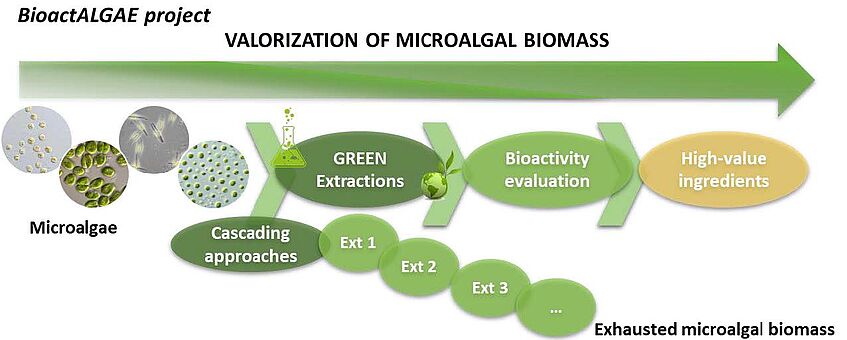Natalia Castejón
Novel cascading approaches based on green chemistry to valorize microalgal biomass by proving potential biological activities

Novel cascading approaches based on green chemistry to valorize microalgal biomass by proving potential biological activities
In recent years, the demand for new bioactive compounds with potential benefits to human health has experienced an outstanding increase. A significant emphasis upon research on marine organisms, like microalgae, has been placed to find novel and sustainable sources of natural compounds. However, extraction methods commonly used for the isolation of these bioactives are focused on the extraction of targeted compounds without the depletion of raw materials. Moreover, these techniques involve the use of high volumes of organic solvents and high energy requirements. In the current context of global warming, EU strategies aim to ensure the sustainable use of the seas while protecting marine environments. A critical concern under this initiative is the valorization of microalgal biomass. Therefore, the search of new processes that will successfully increase the value of microalgal biomass using eco-friendly techniques is nowadays a primary objective.
In this project, an innovative multi-step extraction structure will be implemented through the production of numerous fractions in the form of high value products. Microalgal biomass will be exhausted through stepwise operations, and wastes considered as by-products from the first step will be then valorized to create new added values. In this way, cascading approaches will employ maximum product output and profit from a single raw material. The multidisciplinary nature of the BioactAlgae project will lead to deliver high impact results on the scientific community, but also on health, environmental, industry and society as a whole. Cascading approaches have obvious implications for the potential cost in sustainable marine resource use and may open new routes for the commercial exploitation of microalgal biomass, producing health-promoting ingredients without any wastes from a single source. Furthermore, the project has an additional value due to the main research line that can be used with different microalgae species adapting working conditions.
From a nutritional point of view, microalgae clearly show potential to meet the population’s needs for more sustainable food solutions, and even more if production methods are based on the principles of Green Chemistry. BioactALGAE will provide scientific knowledge for the development of new products in the near future which are particularly relevant for food industry and address commercial opportunities for application in functional products. Additionally, the BioactALGAE project would be the starting point for the next step in bioactivity profiling with specific target compounds and in-depth toxicological studies, continuing with the proof of concept in animal and/or human intervention studies with the final objective of developing novel foods meeting the food production needs for the future.
Thus, BioactALGAE will explore for the first time the valorization of microalgal biomass by exhibiting biological activities of produced extracts using a multi-step extraction method implying eco-friendly techniques, such as enzyme assisted extraction (EAE) or ultrasound assisted extraction (UAE). The originality of the project relies on the use of cascade approaches for green extraction designs as strategies for the valorization of microalgal biomass. After extraction process, an innovative “test first” approach (primary screening) will be performed, followed by characterization and isolation of targeted bioactives from promising extracts. Consequently, BioactALGAE relies on the complete optimization process of microalgal biomass to produce numerous functional bioproducts without any wastes from an original raw material.

